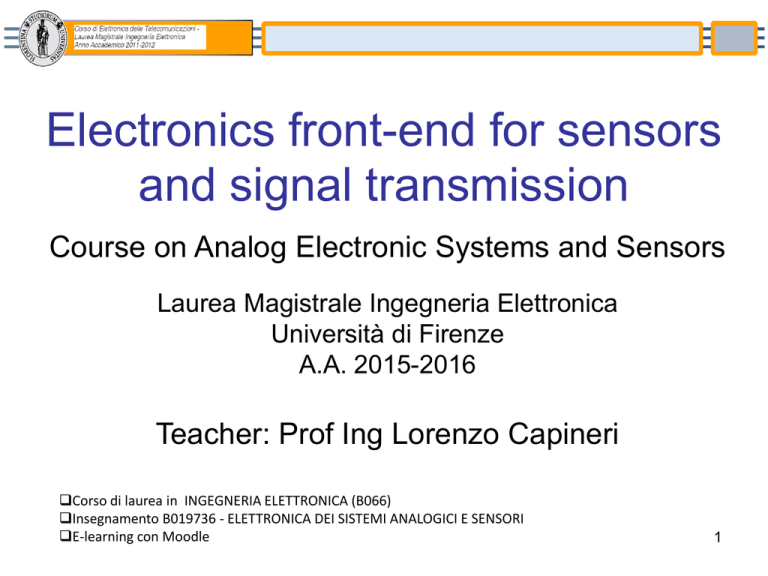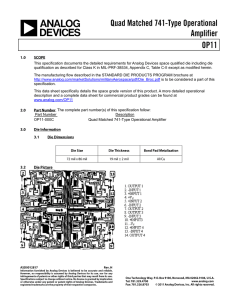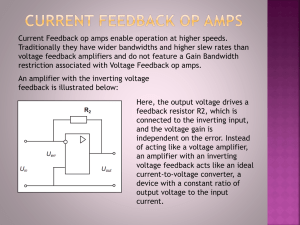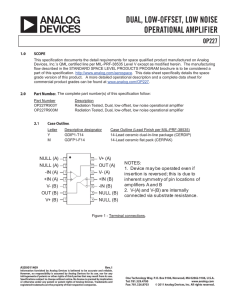Electronics front-end for sensors and signal transmission
advertisement

Electronics front-end for sensors and signal transmission Course on Analog Electronic Systems and Sensors Laurea Magistrale Ingegneria Elettronica Università di Firenze A.A. 2015-2016 Teacher: Prof Ing Lorenzo Capineri Corso di laurea in INGEGNERIA ELETTRONICA (B066) Insegnamento B019736 - ELETTRONICA DEI SISTEMI ANALOGICI E SENSORI E-learning con Moodle 1 Topics Direct transmission of signals. •Methods of connecting sensors to electronic front ends: •Connection with ground referenced or floating sources to single –ended or differential amplifiers, minimization of noise coupling with signal sources. Types of noise sources: conductive, magnetic, capacitive, radiative. •Voltage to Current Converters: Howland current pump, application for 4-20 mA current loop. •Converters Voltage to Frequency and Frequency to Voltage Galvanically isolated transmission of signals. Isolation of analog signals: •Isolation amplifiers with magnetic transformers •Optically isolated analog systems Isolation digital systems: • Microtransformer technology on-chip • Isolation serial and parallel interfaces 2 Direct transmission of signals V to I converter (VCCS) 4 Improved version of V to I converter 5 Applications of V to I converters 6 Transmission of signal with Voltage controlled current source (VCCS) 7 The standard 4-20 mA current loop 8 Active node for a 4-20 mA current loop 9 Differential voltage measurements In many cases Vcm is greater than Vd. Then are necessary op. amp. Featured by : - High CMRR= Ad/Acm (> 80 dB) - High Vcm range (10-200V) Possible solutions: - Subtractors with op. amp. Or differential amplifiers - Instrumentation amplifiers - Switched capacitors subtractors* (Note * : not treated in this course) Instrumentation Amplifier 3 OP.AMP. Balanced inputs, Common mode gain OA1,OA2 =1 Two op. amp. subtractor Unbalanced inputs 2 OP.AMP. This is a modified version of the electrometer amplifier! Subtractor with one Hi-Z input Simplified circuit with one Op Amp Note : the two gain factors for V2 and V1 are different. Subtractors for high Voltages High attenuation for R1>>R2 Good tolerance required for R2//R3 Typical values for V1 and V2 up to 200 V and small |Vcm|<10V Subtractor with differential amplifier c c - Note: the R1 and R2 pair are matched and fabricated with thick film technology on chip, Rs or Rg are designed for the required gain. The differential structure allows a good balance of the amplifier and can provide high CMRR also for radiofrequency applications. Commercial instrumentation amplifiers Instrumentation amplifier for high CMRR and ADC interface The ground noise acts as a common mode and is mitigated by the CMRR of the instrumentation amplifier. 17 Characteristics of AD620 Application of AD620 for pressure resistive sensors Application of AD620 for a medical instrument ECG The common mode potential is controlled by an auxiliary amplifier that is connected to the leg electrode of the patient. Isolation circuits are needed if the instrument if the power supply is connected to the main. Isolated transmission of signal The galavanic isolation method is used when voltage differences are superimposed to very high common mode voltages in order of 100 - 1000 V, well above the absolute maximum rating voltages of integrated instrumentation amplifiers. Block scheme of a galvanic isolated analog system Coupling: optical/magnetic/capacitive V1 Transmitter Vout V1 Receiver GND +Vcc -Vcc GND +Vcc -Vcc Isolated reference Cparassita1 1u Isolated Power Supply Oscillator Power Supply Analog system ground reference Trasformatore 1u DC/AC Conv. Cparassita2 22 Isolation Barrier Galvanic Isolation The galvanic isolation is adopted to obtain high CMRR at board design level. The sensors front-end can be isolated from the measuring circuit or ADC by ground references separation. This can be obtained by coupling the transmitting and receiving circuits with: 1.Optical coupling (LED and photodiode) 2.Magnetic coupling (transformer) 3.Electrostatic coupling(capacitors) The isolated section of the analog system requires an isolated power supply obtained with switching power supply (DC-DC converters) or battery powered. 23 Static common mode voltage In some cases the DC component of the common mode voltage (VCM(DC) ) is high and adequate insulating materials must be adopted to withstand the electric field. The minimum distance Dmin between the isolated sections of the board or the device can be calculated: Dmin = VCM(DC) / Ec Where Ec is the dielectric rigidity of the material : Air Mica Teflon (PTFE) Polymide Ceramic Ec=30 kV/cm Ec=2000 kV/cm Ec=300-400 kV/cm Ec=2910 kV/cm Ec=3500 kV/cm Used in hybrid microcircuits 24 Dynamic common mode voltages For transient of common mode voltages the magnetic transformer can be used but the effect of parasitic capacitances across the primary and secondary windings must be considered. Example: Vcm: 3 kV peak, rise time 8 µs, Duration 1 µs, fall time 20µs, V_diff= 100 mV, 1 kHz 25 Differential voltage output Transient noise of 120 mV pp and 160 us duration 26 Mitigation of the effects of parasitic capacitances of magnetic transformers The parasitic capacitances can be reduced to about 10 pF by using toroidal transformer with shielded windings. Cpar2 Cpar1 U1 Cpar4 Cpar3 x http://www.coilcraft.com/ 27 Block scheme of Isolation Amplifier AD 202 28 Comparison of Isolation Amplifiers 29 Thermocouple with isolation amplifier B A C A: Thermocouple Sensor and signal conditioning ; B: output ; C: power supply 30 Ref: Data sheet Analog Devices – Isolation_Amplifier.pdf Analog signal transmission by isolated optical coupling (1 of 3) For the transmission of an analog signal an optical channel can be used to obtain high level of isolation. The voltage signal can drive a LED by a voltage to current (V to I) converter. The non linear characteristic response of the LED I=f(V) needs to be corrected to avoid signal distortion and loss of information. Integrated optocouplers with negative feed back loop can provide linear response. 31 Schematic with optical couplers (2 of 3) +Vcc V1float 0 +Vcc V1float 0 R5 1K R3 R2 1K 1K R5 R3 1K R4 Op_AMP1 R1 R41K 1K R2 1K 1K Op_Amp2 Op_AMP1 Q1R1 1K Op_Amp2 Vout beta= 1K 122 V1 Q1 beta= 122 Q2 Vout D1 V2 beta= 122 D1 Q2 beta= D2 122 V2float 0 Sy stem Ground -Vcc D2 V2float -Vcc Sy stem Ground 0 Ground Float Ground Float 32 Transfer function (3 of 3) V1 V2 V1 float V1 IcQ 2 R5 R4 R5 R4 Vcc Vout IcQ1 R3 R2 hp ) IcQ1 IcQ 2 V1 float Vcc V1 float Moreover if , then : R3 R5 R2 R2 Vout (V1 V2 ) V1 R4 R4 hp )V2 0 33 Transmission of voltage signals with long range connections To mitigate the EMI for long range connections in harsh environments, the transmission channel can be fully optical, like optical fibers. With this solution isolation amplifier are not needed but local power supply system must be provided for the sensors and the front end. Digital Modulation of a sensor signal with a Voltage to Frequency converter 35 V/F and F/V converters The analog input voltage signal is converted in a frequency modulated square wave. The frequency (fosc) of the square wave is proportional to the instantaneous input voltage amplitude. The square wave drive the transmitting LED (or laser diode) . The ideal Voltage to frequency converter function is: fosc (t) = k V1(t) Where V1(t) is the input voltage. This circuit belong to the broad class of circuit called VCO (Voltage controlled Oscillator). At the end of the fiber optic the voltage amplitude is restore with a inverse function that is a Frequency to voltage converter. Main design issues for V/F and F/V converters are: • Input dynamic voltage range • Bandwidth • Linearity • Power consumption 36 Voltage to Frequency converter 37 VFC32 TI data sheet : http://www.ti.com/lit/ds/symlink/vfc32.pdf Voltage to Frequency converter 38 Voltage to Frequency converter 39 Frequency to Voltage converter For each pulse, the capacitor charging is activated with a constant current for a predetermined time. The discharge constant is designed according to the value of the frequencies to be converted. The average value of the voltage on the capacity depends linearly on the frequency of the input pulses. Frequency to Voltage converter Frequency to Voltage converter Remote Transducer Readout via Fiber Optic Link with analog and digital output 43 Typical applications of F/V converter with sensors The integrated light-to-frequency converter outputs a square wave (50% duty cycle) with frequency directly proportional to light intensity (irradiance). 44 Isolated digital systems with on-chip microtransformer 45 Ref: Data sheet Analog Devices – ADuM524x.pdf Isolated digital systems with onchip microtransformer Pout_max=50 mW The design of 3 on chip microtransformer has allowed to reduce the component dimension to be suitable for compact electronic systems. 46 On-chip microtransformer 1 power suppy microtransformer with lower number of turns and larger conductor sections 2 signal microtransrmers for two channels connections On chip electronics for signal transmission (transformer driiver) and switched mode power supply 47 Technology of microtransforers The wounds are metal deposition of (AlCu-Au) on a polymide insulation layer. This High Frequency transformers are characterized by a low L/R. 48 Ref: Data sheet Analog Devices – isoPower.pdf – Dec .2006 isoPower Technology For a microtransformer with diameter 600 m, the switching frequency is 300 MHz, to achieve a high efficiency in power conversion. 49 Isolated Serial/Parallel interfaces The integrated solution is more compact respect to the hybrid one (e.g. AD200x) for low power and isolation voltages of 5 kV. Custom solutions for project spec’s require longer times for realization, certification and testing. 50 Inter Integrated Circuits (I2C) bus with galvanic isolation I2C is a standard bus for electronic systems for the communication between a master/control board and peripherals, through two active wires. One wire is for data transfer and one for the clock. Typical data-rate 1 Mbps. 51 52 References •Sections 20.1.3 and 21.4 of Tietze-Schenk, Electronic Circuits, 2° Edition •AD202/AD204, data sheet Analog Devices •Isolating I2C interfaces, data sheet Analog Devices •isoPower, data sheet Analog Devices •LM131, data sheet National Semiconductor •Trasformatori in Alta Frequenza, dispense prof Lorenzo Capineri 53




